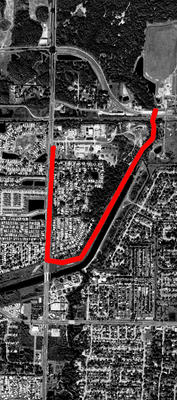
title excerpted from W.C. Williams' "Paterson"
North UTBT 3mi
I think that I needed the two days off to rest my legs a bit, and the weekend was pretty hectic anyhow. I’m thinking of swapping my Saturday and Sunday routines so that I run on Sunday. This makes it easier to crosstrain because the gym is always open on Saturday. I think a lot of other training programs have the day off following the long run, and I think this might be more to my liking as well.
Today I was back to work and my training schedule called for crosstraining, but I was feeling a little guilty about skipping the last few days and I felt like I should get some running in. I ran the UTBT three-mile out-and-back route at a nice 11:00 pace. My legs felt tight the whole way, but they never got truly painful.
Cardiovascularly, I am definitely improving, even if musculoskeletally I can’t keep up. My pace this morning felt very comfortable and my heart rate at the split was still only 140. I see more and more how the temperature affects my heart rate, and I would guess that for every degree increase in temperature, my heart rate increases by about two beats per minute. I’m working on developing a formula that shows improved efficiency through training. This would be a measure of heart rate as compared to running pace.
Today I read some of Denis Wood’s writing online, as well as a short story by Barry Lopez titled “The Mappist”. I was struck by the similarities between these real and fictional characters (Denis Wood and Corlis Benefideo), and I began thinking more about what it is that is driving this project of mine. I realize that I still don’t have a distinct focus. I see more and more that my runs function more as reconnaissance than as research. For me to form a truly detailed and comprehensive map, I must read the histories of this city in its books, as well as in its streets and in the mouths and imaginations of its people. As Lopez writes in “The Mappist”, Benefideo’s book is based on the idea that the city is “the living idea of its inhabitants”.
InIra Glass’s interview with Denis Wood he says that Wood’s maps “make the neighborhood seem like a living organism”, to which Wood responds, “It is a living organism!”
Carlo said to me “your aerial maps look like pictures of Hiroshima,” and I saw the brutality in these images. It was not my intent to lay this city to waste. Today I’m thinking of softer representations of this city. I’m imagining a 3-D model on the brick floor of Flight 19 made of Cuban coffee and tobacco leaves. I’m thinking of hand-drawn maps on rag paper, I’m thinking about water; where it moves, collects, rises and falls. And I’m wondering why every city calls itself the “Lightning Capital of the World”.